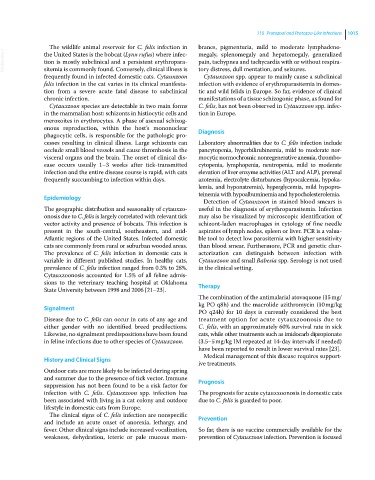Page 1077 - Clinical Small Animal Internal Medicine
P. 1077
110 Protozoal and Protozoa‐Like Infections 1015
The wildlife animal reservoir for C. felis infection in branes, pigmenturia, mild to moderate lymphadeno-
VetBooks.ir the United States is the bobcat (Lynx rufus) where infec- megaly, splenomegaly and hepatomegaly, generalized
pain, tachypnea and tachycardia with or without respira-
tion is mostly subclinical and a persistent erythropara-
sitemia is commonly found. Conversely, clinical illness is
Cytauxzoon spp. appear to mainly cause a subclinical
frequently found in infected domestic cats. Cytauxzoon tory distress, dull mentation, and seizures.
felis infection in the cat varies in its clinical manifesta- infection with evidence of erythroparasitemia in domes-
tion from a severe acute fatal disease to subclinical tic and wild felids in Europe. So far, evidence of clinical
chronic infection. manifestations of a tissue schizogonic phase, as found for
Cytauxzoon species are detectable in two main forms C. felis, has not been observed in Cytauxzoon spp. infec-
in the mammalian host: schizonts in histiocytic cells and tion in Europe.
merozoites in erythrocytes. A phase of asexual schizog-
enous reproduction, within the host’s mononuclear Diagnosis
phagocytic cells, is responsible for the pathologic pro-
cesses resulting in clinical illness. Large schizonts can Laboratory abnormalities due to C. felis infection include
occlude small blood vessels and cause thrombosis in the pancytopenia, hyperbilirubinemia, mild to moderate nor-
visceral organs and the brain. The onset of clinical dis- mocytic normochromic nonregenerative anemia, thrombo-
ease occurs usually 1–3 weeks after tick‐transmitted cytopenia, lymphopenia, neutropenia, mild to moderate
infection and the entire disease course is rapid, with cats elevation of liver enzyme activities (ALT and ALP), prerenal
frequently succumbing to infection within days. azotemia, electrolyte disturbances (hypocalcemia, hypoka-
lemia, and hyponatremia), hyperglycemia, mild hypopro-
teinemia with hypoalbuminemia and hypocholesterolemia.
Epidemiology
Detection of Cytauxzoon in stained blood smears is
The geographic distribution and seasonality of cytauxzo- useful in the diagnosis of erythroparasitemia. Infection
onosis due to C. felis is largely correlated with relevant tick may also be visualized by microscopic identification of
vector activity and presence of bobcats. This infection is schizont‐laden macrophages in cytology of fine needle
present in the south‐central, southeastern, and mid‐ aspirates of lymph nodes, spleen or liver. PCR is a valua-
Atlantic regions of the United States. Infected domestic ble tool to detect low parasitemia with higher sensitivity
cats are commonly from rural or suburban wooded areas. than blood smear. Furthermore, PCR and genetic char-
The prevalence of C. felis infection in domestic cats is acterization can distinguish between infection with
variable in different published studies. In healthy cats, Cytauxzoon and small Babesia spp. Serology is not used
prevalence of C. felis infection ranged from 0.3% to 28%. in the clinical setting.
Cytauxzoonosis accounted for 1.5% of all feline admis-
sions to the veterinary teaching hospital at Oklahoma Therapy
State University between 1998 and 2006 [21–23].
The combination of the antimalarial atovaquone (15 mg/
kg PO q8h) and the macrolide azithromycin (10 mg/kg
Signalment
PO q24h) for 10 days is currently considered the best
Disease due to C. felis can occur in cats of any age and treatment option for acute cytauxzoonosis due to
either gender with no identified breed predilections. C. felis, with an approximately 60% survival rate in sick
Likewise, no signalment predispositions have been found cats, while other treatments such as imidocarb dipropionate
in feline infections due to other species of Cytauxzoon. (3.5–5 mg/kg IM repeated at 14‐day intervals if needed)
have been reported to result in lower survival rates [23].
Medical management of this disease requires support-
History and Clinical Signs
ive treatments.
Outdoor cats are more likely to be infected during spring
and summer due to the presence of tick vector. Immune Prognosis
suppression has not been found to be a risk factor for
infection with C. felis. Cytauxzoon spp. infection has The prognosis for acute cytauxzoonosis in domestic cats
been associated with living in a cat colony and outdoor due to C. felis is guarded to poor.
lifestyle in domestic cats from Europe.
The clinical signs of C. felis infection are nonspecific
and include an acute onset of anorexia, lethargy, and Prevention
fever. Other clinical signs include increased vocalization, So far, there is no vaccine commercially available for the
weakness, dehydration, icteric or pale mucous mem- prevention of Cytauxzoon infection. Prevention is focused

